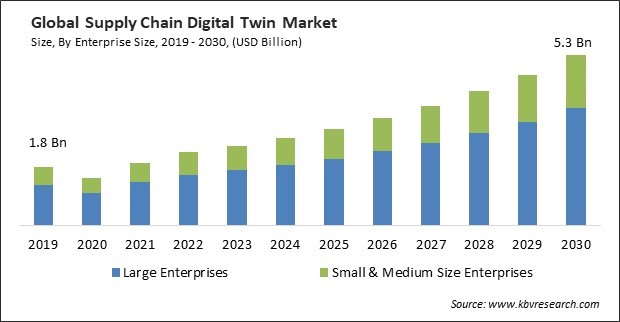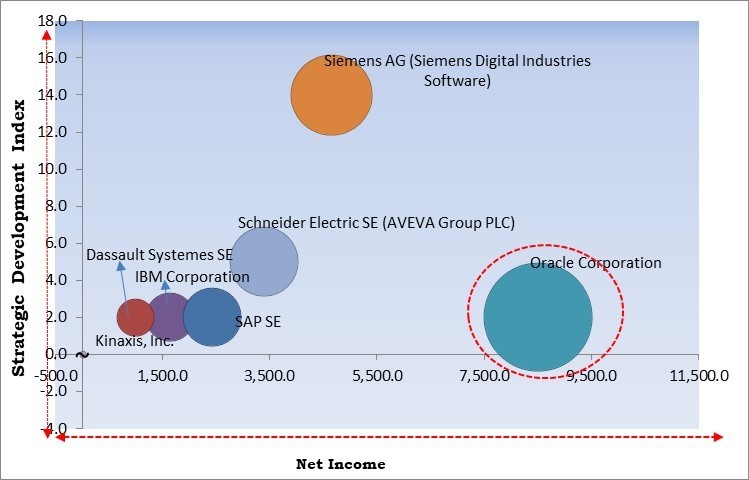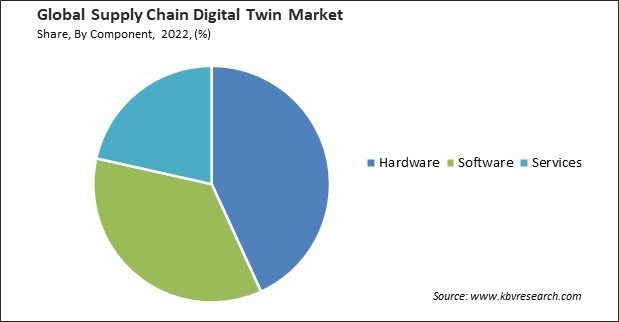The Global Supply Chain Digital Twin Market size is expected to reach $5.3 billion by 2030, rising at a market growth of 11.5% CAGR during the forecast period.
Services are a vital component in the market, offering expertise in implementation, integration, and ongoing support. Thus, the Services segment would achieve a $1.2 billion market share by 2030. Service providers assist businesses in customizing digital twin solutions to their unique supply chain needs. They offer consulting, training, and maintenance services, ensuring seamless adoption and maximizing the benefits of digital twin technology. These services also encompass data analysis, helping companies derive actionable insights from digital twin models. Service providers play a crucial role in troubleshooting, updates, and scaling digital twin applications, enabling businesses to adapt to changing market dynamics efficiently. Their expertise ensures that organizations harness the full potential of Supply Chain Digital Twins, optimizing operations and enhancing overall supply chain efficiency.

The major strategies followed by the market participants are Partnerships as the key developmental strategy to keep pace with the changing demands of end users. For Instance, in February, 2021, IBM joined hands with Siemens and Red Hat. This collaboration aims to utilize a hybrid cloud designed to provide a flexible, open and safe solution for manufacturers & plant operators to lead the real-time value from operational data. Moreover, In February, 2019, Dassault Systemes SE came into partnership with ABB Ltd., a Swedish Swiss multinational corporation. Under this partnership, both companies aimed to develop and offer customers advanced digital twins, allowing customers to run ABB’s solutions and their operations with improved overall efficiency, flexibility, and sustainability.
Based on the Analysis presented in the KBV Cardinal matrix; Oracle Corporation is the major forerunner in the Market. In April, 2022, Oracle Corporation partnered with Maplesoft, the leading provider of high-performance software tools for engineering, science, and mathematics. This partnership aimed to integrate Oracle’s cloud technology and Maplesoft’s simulation software for customers to create extremely versatile digital twins at scale with physics-based models on operational data. Companies such as Siemens AG (Siemens Digital Industries Software), Schneider Electric SE (AVEVA Group PLC) and SAP SE are some of the key innovators in the Market.

As global supply chains expand and become more intricate, companies face the challenge of managing a vast network of suppliers, manufacturers, distributors, and logistics providers. This complexity makes having a clear and real-time view of the supply chain difficult. SCDTs offer a comprehensive and unified view of the supply chain, allowing stakeholders to monitor all process aspects in real-time. Additionally, complexity often leads to inefficiencies in supply chain operations. With numerous stakeholders and processes involved, optimizing production, inventory, transportation, and distribution becomes challenging. SCDTs provide advanced analytics and modeling capabilities that allow companies to identify opportunities for improvement and optimization. These factors will drive the future expansion of the market.
E-commerce's rapid rise has led to an increase in supply chain complexity. With the proliferation of online marketplaces, the diversity of products, and the need for rapid order fulfillment, supply chains have become more intricate. Supply chain digital twins provide a dynamic and detailed representation of these complex supply chain networks, enabling organizations to manage and optimize their operations efficiently. In addition, e-commerce relies heavily on data-driven decision-making. It provides advanced data analytics and visualization tools that empower e-commerce companies to make informed decisions. By analyzing real-time data and simulating different scenarios, e-commerce businesses can optimize their supply chain operations, reduce costs, and enhance overall efficiency. Therefore, the growth of e-commerce has driven the demand for these solutions.
Implementing an SCDT often requires a significant upfront investment in technology, software, hardware, and personnel with expertise in digital twin development. For organizations with limited budgets, especially smaller businesses, the high initial costs can deter them from adopting SCDTs. Developing and integrating an SCDT demands specialized data analytics, IoT, software development, and supply chain management skills. Talent with these skills can be hard to come by and expensive to keep. Moreover, data quality is critical for the accuracy and reliability of an SCDT. Inconsistent or inaccurate data from various sources can compromise the effectiveness of the digital twin. Ensuring data quality and standardization across the supply chain ecosystem can be time-consuming and resource-intensive. The supply chain ecosystem often involves multiple stakeholders who use different software platforms and technologies. Ensuring interoperability between these systems and the SCDT can be a challenge. This can create friction in collaborations and slow down the adoption of SCDTs. These factors will impede the future growth of the market.

The leading players in the market are competing with diverse innovative offerings to remain competitive in the market. The above illustration shows the percentage of revenue shared by some of the leading companies in the market. The leading players of the market are adopting various strategies in order to cater demand coming from the different industries. The key developmental strategies in the market are Partnerships & Collaborations.
Based on enterprise size, the market is bifurcated into large enterprises and small & medium size enterprises (SMEs). In 2022, the small & medium size enterprises (SMEs) segment garnered a significant revenue share in the market. SMEs often operate with limited budgets compared to larger corporations. Digital twin technology providers have recognized this and are offering cost-effective solutions catering to SMEs' budget constraints. These solutions typically come with lower upfront costs, subscription-based pricing models, and scalability options, making them more accessible to smaller businesses. SMEs often have niche or specialized supply chain requirements. Digital twin solutions are becoming more customizable, allowing SMEs to tailor the technology to their needs and processes. This adaptability ensures that SCDTs can address the unique challenges smaller enterprises face. Owing to these factors, there will be an increased demand in the segment.
Based on component, the market is segmented into hardware, software, and services. In 2022, the software segment garnered a significant revenue share in the market. Software solutions enable companies to conduct scenario analysis and simulations, allowing them to assess the impact of various supply chain decisions, disruptions, or changes. This capability is crucial for optimizing supply chain strategies and resource allocation. Advanced software solutions seamlessly integrate real-time data from IoT sensors, RFID tags, and other sources, providing a comprehensive view of supply chain activities. This real-time integration enhances decision-making and responsiveness. AI and ML algorithms embedded in supply chain digital twin software offer predictive analytics capabilities. These algorithms can forecast demand, identify trends, and optimize inventory levels, leading to reduced costs and improved supply chain performance. As a result, the segment is expected to proliferate in the future.

On the basis of deployment mode, the market is divided into on-promise and cloud. In 2022, the cloud segment witnessed a substantial revenue share in the market. Cloud-based SCDT solutions can easily scale to accommodate the growing complexities of supply chains. Whether a business is a small startup or a multinational corporation, cloud platforms can adapt to their needs, making them suitable for various companies. Cloud-based SCDTs are accessible from anywhere with an internet connection. This accessibility enables supply chain stakeholders to access real-time data and collaborate seamlessly, even when geographically dispersed. Owing to this, the cloud segment will witness an increased demand in the coming years.
On the basis of vertical, the market is divided into manufacturing, automotive, aerospace & defense, retail, pharmaceuticals, consumer goods, and others. In 2022, the manufacturing segment witnessed a substantial revenue share in the market. SCDTs enable manufacturers to create accurate demand forecasts by considering historical data, market trends, and real-time information. This, in turn, helps optimize production planning and align it with customer demand. SCDTs provide visibility into the availability of resources, including raw materials, machinery, and labor. Manufacturers can optimize resource allocation to meet production targets efficiently. Therefore, the demand is expected to rise in the manufacturing segment.
| Report Attribute | Details |
|---|---|
| Market size value in 2022 | USD 2.3 Billion |
| Market size forecast in 2030 | USD 5.3 Billion |
| Base Year | 2022 |
| Historical Period | 2019 to 2021 |
| Forecast Period | 2023 to 2030 |
| Revenue Growth Rate | CAGR of 11.5% from 2023 to 2030 |
| Number of Pages | 299 |
| Number of Table | 463 |
| Report coverage | Market Trends, Revenue Estimation and Forecast, Segmentation Analysis, Regional and Country Breakdown, Market Share Analysis, Competitive Landscape, Companies Strategic Developments, Company Profiling |
| Segments covered | Component, Deployment Mode, Enterprise Size, Vertical, Region |
| Country scope | US, Canada, Mexico, Germany, UK, France, Russia, Spain, Italy, China, Japan, India, South Korea, Singapore, Malaysia, Brazil, Argentina, UAE, Saudi Arabia, South Africa, Nigeria |
| Growth Drivers |
|
| Restraints |
|
By region, the market is segmented into North America, Europe, Asia Pacific, and LAMEA. The North America segment procured the highest revenue share in the market in 2022. Many of the world's largest and most influential companies, particularly in manufacturing, retail, and logistics, are headquartered in North America. These industry leaders have been early adopters of SCDT technology, driving awareness and setting industry standards for digital twin implementations. The region is home to companies with extensive and complex supply chains that span national and international boundaries. Managing these intricate networks requires advanced tools like SCDTs to optimize processes, enhance visibility, and mitigate risks. These factors are expected to boost the demand in the North America segment.
Free Valuable Insights: Global Supply Chain Digital Twin Market size to reach USD 5.3 Billion by 2030
The market research report covers the analysis of key stake holders of the market. Key companies profiled in the report include IBM Corporation, Oracle Corporation, SAP SE, Dassault Systemes SE, Kinaxis, Inc., Schneider Electric SE (AVEVA Group PLC), Siemens AG (Siemens Digital Industries Software), AnyLogic North America, LLC (The AnyLogic Company), Simio LLC and Logivations GmbH
By Enterprise Size
By Component
By Deployment Mode
By Vertical
By Geography
The Market size is projected to reach USD 5.3 billion by 2030.
Rising complexities in the global supply chain are driving the Market in coming years, however, Challenges due to complex implementation processes restraints the growth of the Market.
IBM Corporation, Oracle Corporation, SAP SE, Dassault Systemes SE, Kinaxis, Inc., Schneider Electric SE (AVEVA Group PLC), Siemens AG (Siemens Digital Industries Software), AnyLogic North America, LLC (The AnyLogic Company), Simio LLC and Logivations GmbH
The On-premise segment is generating the maximum revenue share in the Market by Deployment Mode achieving a market value of $2.78 billion by 2030.
The On-premise segment is leading the Market, By Deployment Mode in 2022 thereby achieving a market value of $1.2 billion by 2030.
The North America region dominated the Market by Region in 2022 and would continue to be a dominant market till 2030; thereby, achieving a market value of $1.8 billion by 2030.
Our team of dedicated experts can provide you with attractive expansion opportunities for your business.

